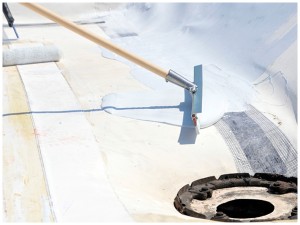Application of Liquid Rubber Coatings Starts with Preparing the Surface
The application of liquid rubber coatings is easiest when the surface is flat, clean and smooth. As is the case with all painting jobs, the most time-consuming part could be cleaning and repairing the surface.
How to clean the surface depends on the material. For metal roofs, sweeping and/or washing may be all that is necessary. You should make sure there is no debris on the surface, because any debris will show through the coating.
Concrete floors should be as smooth as possible. If cracks or holes are present in any material, fill them with a non-silicone based caulking. The rubber would fill the hole, but a dent would still be visible. Depending on the depth of the hole, this could cause a variety of problems in the future.
For some older roofing materials, it is a good idea to reinforce the surface with butyl tape and polyester fabric. For example, if there are gaps, tears or other defects, you would want to correct those problems. Although the coating does not adhere to all materials, it does adhere to fabric.
Depending on the surface to be covered, a catalyst coating may be needed. For example, the application of liquid rubber coatings to existing asphalt-based roofs requires a pre-coating with an elastomeric catalyst. Follow the manufacturer’s directions concerning what type of pre-coating to use.
Generally speaking, latex house paint is not an acceptable solution.
You will need a squeegee, a roller and a paint brush to apply the coating, once the surface has been prepared. The thickness usually recommended for the coating is 20-mil. It may be necessary to do a spreading rate calculation to get an idea of how that thickness can be achieved. A good estimate for a flat smooth surface is 40 feet per gallon. The application of liquid rubber coatings to uneven surfaces will require more.
The product needs to be spread as evenly as possible. You want to avoid making it thicker in some spots and thinner in other areas. The squeegee is used initially to spread the material. It is recommended to follow the use of the squeegee with a roller to promote more even distribution and get rid of any air bubbles that may be trapped within the liquid.
The first 2 gallons usually take one or two hours to apply. If you have already determined how many gallons you need, this should give you an idea of how long the application of liquid rubber coatings will take. You should be able to get the job done in a day.


